Samuel T. Adams: The Language and Performance of Painting

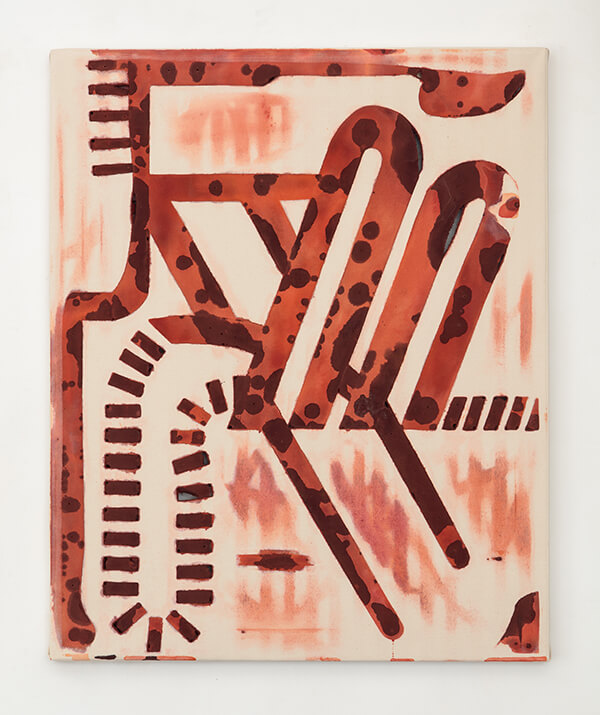
Resembling hieroglyphs, symbol-laden maps, industrial icons and other curiously coded linguistic signs, Brooklyn-based artist Samuel T. Adams’ mysterious paintings appear as if they’re trying to tell us something. Partially influenced by the topographical maps and aerial photographs employed by his father who was a land developer, Adams’ imaginative and occasionally oddly shaped canvases encourage viewers to attempt to decipher their ambiguous imagery.

With their rips, tears and vibrant colors as seen in Adams’ current solo show By Night With Torch and Spear at Dutton, Adams’ paintings present a tangible physicality derived from his innovative multistep process. Combining techniques of painting, sculpture and printmaking to create work that defies easy categorization, Adams begins by constructing a sculptural wood structure to be used as a stretcher. Wet-sanding a stretched canvas, Adams allows the pigment-infused water to soak into the complex wooden composition. Adams then flips the canvas inside out and restretches the work, revealing the ethereal finished painting as a record of his performative practice.
We visited Adams’ studio in Bushwick as he prepared for his weekly Tuesday film-screening series Tenant416. Showing us the preparatory steps integral to his paintings, we spoke with Adams about his current exhibition, his labor-intensive process and how he would like to foster dialogue through both his art and Tenant416.
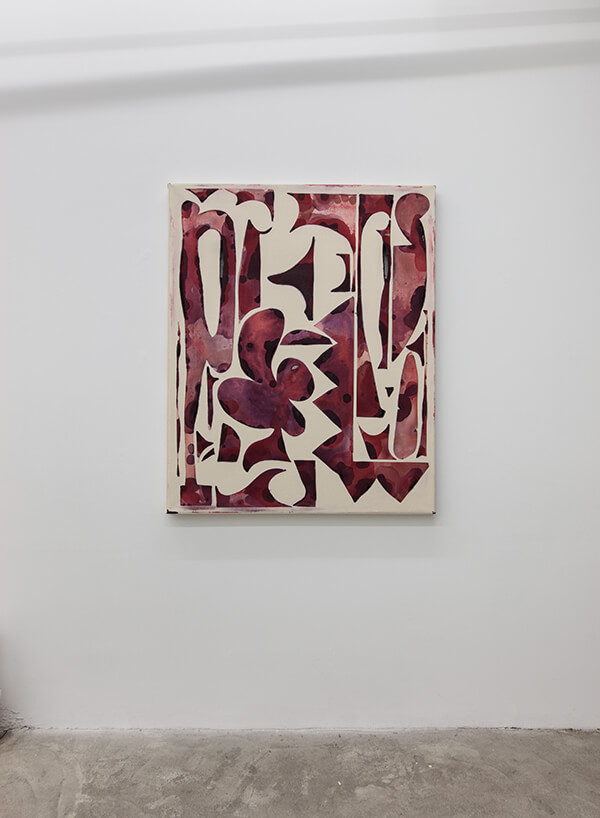
The title for your exhibition By Night With Torch and Spear references Joseph Cornell’s 1942 surreal short film that combines found tribal, industrial and other footage with effects including flipping the film upside down. With similar industrial imagery and emphasis on process, do you see a connection between Cornell’s film and your paintings?
Searching for titles is such a funny thing. Often I search through films and film titles to come up with titles for paintings. I saw that film title and it had been a long time since I had seen the film. It just made complete sense. The whole notion of “by night”–I’m very nocturnal. I make all my work until like five in the morning. I work all night. When I read it, it just struck and I thought, “That’s the title.” Of course, the imagery in the film relates as well with the industriousness. Some of the paintings almost resemble machines. Also in the film, the imagery is flipped backward and upside down. These canvases are actually the back of the canvas. Even the imagery of men pouring liquid metal in the film resembles the fierce brutality I put these paintings through. The tribal rituals in the film are also emblematic of an artist’s practice. It’s a complete culmination. It’s kind of vague, but at the same time, it made so much sense.
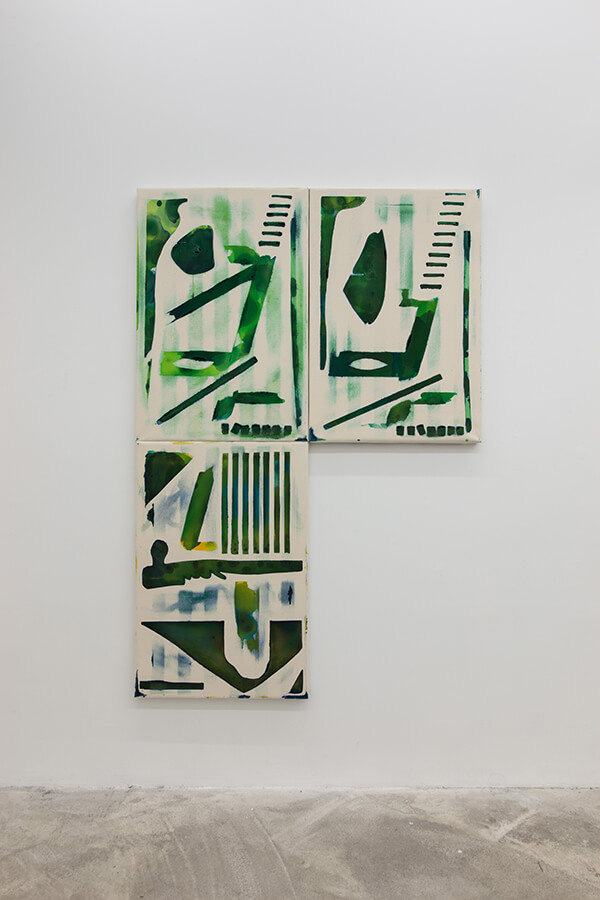
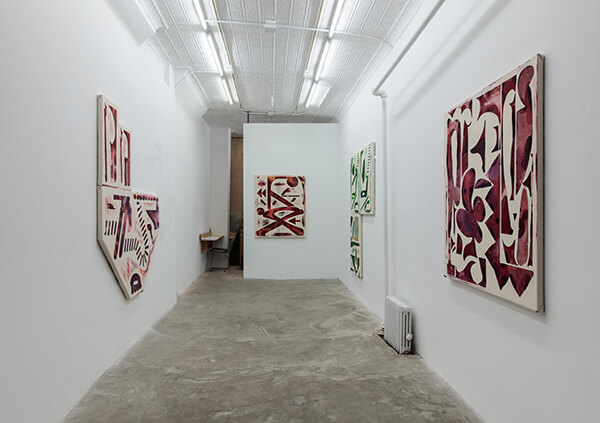
You mentioned the rigorous and sometimes destructive act of your painting, which seems quite complex. Is trial-and-error and experimentation an essential part of your practice?
It’s not just a one-and-out thing. I’ll unstretch the canvas and be like, “Oh, this composition sucks.” Then I have to toss that canvas and start over. Sometimes there will be a rip that keeps stretching until the whole painting is ripped. Sometimes it needs more pigment, the color is off or it’s just awful. It can be extremely frustrating if just one thing is off. I started over on one of the paintings I took to the gallery that actually isn’t in the show four times–restretching, priming and doing the under-painting. Tons of paint wasted to only realize that this composition is way off and I need to mess with the stretcher. It is a lot of trial-and-error.
As far as experimenting goes, recently I’ve been trying to play with color and not being afraid to use lots of different colors on one painting. I feel like the paintings in the show aren’t as monochromatic as previous work. I’m also always trying to make the shapes themselves more awkward. There’s one painting in the show that almost feels like a collage. It has this club shape. I got a jigsaw so I was able to start introducing a lot of curves and curvilinear shapes. That club shape was almost an ode to Richard Diebenkorn’s Clubs and Spades.
Speaking of the shapes within your paintings, the shapes of the canvases are also often quite remarkable, resembling boats or ladles. What inspired you to begin altering the shape of the canvas itself?
I had been making multi-panel pieces for a few years. I’d have four rectangular canvases, making one larger rectangle. Having four separate canvases allowed me to play with it like a puzzle. At one point, I had three canvases and it just made more sense with three than with the complete four. That was the beginning of the shaped canvases. I don’t know what really prompted that awkward shape, but once I made it, they felt like these ghost ships. At the show in May [Adams’ exhibition Agapē Agape held by Dutton in a pop-up space across from the Whitney Museum], all these people were posing in front of my paintings making the peace sign and using the emoticon for a peace sign. It’s like this accidental emoticon or emoji. I thought it was awesome. I think a lot about iconography of language–the shape of letters–and the iconography of language of our times is the emoji. It makes complete sense in this weird way and it’s also kind of hilarious. I want the paintings to be humorous.
Through your unique process, you merge sculpture, painting and printmaking. What interests you about combining these three disciplines?
It all started in grad school. I trained as a printmaker and I worked at Crown Point Press in San Francisco, which is a very prestigious press. After Crown Point Press, I was void of printmaking facilities and wondered how I was going to make work because I didn’t feel I was a painter. I was making paintings through these removed processes like pouring paint and tilting the canvas or firing it with a hairdryer to make it crack. Everything was a removed process. Once I got to grad school, all my professors asked, “Why don’t you just use a paintbrush?” I was like, “I haven’t painted–actually painted–since 2002.” By the end of grad school, I was making these huge overworked, almost gaudy awful paintings. I became a painter that makes a mark then steps back to react to it. It’s really hard for me to do that and I drove myself insane. So I tried something else. I made these masked geometric paintings based on collage and thought, “These are awesome.” Then I went to Holland for a month on a residency, came back and thought, “These are awful.” I started destroying them by wet-sanding them and I noticed what was happening. I saw the pigments were collecting where the stretcher bars were and that was the turning point. But to answer your question, I love building stuff. Almost everything in here, I built. It’s very gratifying. I love woodworking. In the end, it comes down to this reversal of the notion of printmaking. The indirectness is key for me.
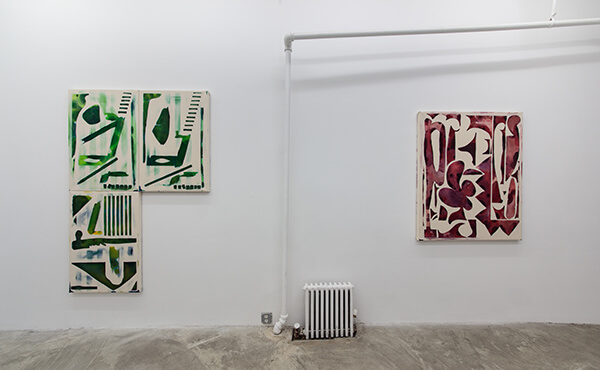
In addition to art, you also run Tenant416, a weekly curated film program in your studio. What led you to start Tenant416?
It was both inspired by and a reaction to the so-called Bushwick art scene, as well as having friends that have done rigorously programmed D-I-Y exhibitions. It’s my way of curating my own thing, but not hanging art on the walls. It’s my way of sharing cinema. I was going to Bushwick openings and seeing the same people and the same stuff. It’s a way of presenting work that I hope no one or not that many people have seen, especially in 16mm. Furthermore, I want to open a conversation and have a different kind of platform. When I go to Bushwick openings–or openings anywhere, I have the same conversations. In September, I can’t tell you how many times I was asked, “How was your summer?” Here, it started off as just my friends coming. Now, it’s total strangers and nerds, which is exactly what I want–people who just want to come and talk about film. I think film is the most powerful medium there is.
Do you want to similarly provoke conversations between viewers of your paintings?
I definitely want to have an open conversation. It’s so hard for me to even talk about the paintings in the same way it’s hard to talk about film in some cases. If you sit and ponder them long enough, there’s definitely something you can extract. My first feature writing on film for Brooklyn Magazine was about this experimental filmmaker Dore O. and a retrospective of her work at Spectacle. It defies genre and in some cases, even description. I’m like, “How do I write about this?” But if you spend enough time with it, you are able to extract something. Hopefully, it’s the same way with the paintings. I don’t know what–maybe that sounds irresponsible, but I just have this drive. I don’t know how to not make work. It’s almost indescribable. People ask me all the time why I don’t make film. It’s because I need to make paintings.











Responses